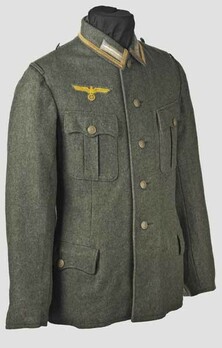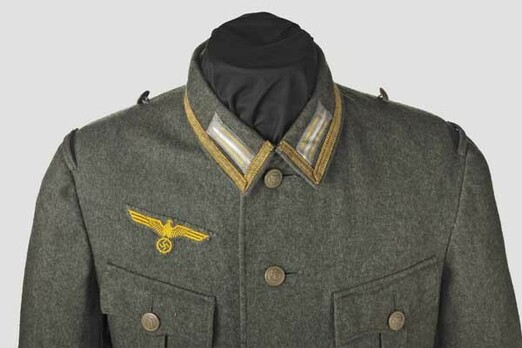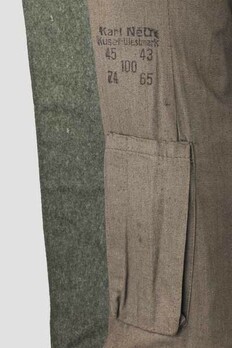Kriegsmarine Coastal Artillery Field Blouse
CATEGORY: Version
SKU: 21.GOR.02.01.01.003.000
Estimated market value:



Estimated market value:
The headgear, uniforms, and insignia worn by members of the Kriegsmarine were based upon the designs utilized by the Kaiserliche Marine (Imperial Navy) and the Reichsmarine (Navy of the Weimar Republic). The official regulations governing the uniforms of the Reichsmarine were issued on April 5, 1921, and they were embraced, with a few alterations, as the Kriegsmarine uniforms in 1935.
From 1933 to 1945, the uniforms worn by personnel in the German Navy were produced and disseminated by the Navy Clothing Depot and private manufacturers. The cloth was of a high quality prior to the Second World War, but during the war, it became increasingly synthetic and of lower quality. Similarly, the cloth used in the uniforms of Officers and Admirals was of a higher quality than the cloth used in the uniforms of lower ranking personnel, such as Non-Commissioned Officers and Enlisted Men. The cloth utilized in garments of the blue uniform is of an overall better quality than the cloth utilized in the field-grey uniform. For the field-grey uniform specifically, the cloth is more grey-coloured in pre-war uniforms, while the cloth is more green/olive-coloured in wartime uniforms.
The main colour of Kriegsmarine uniform pieces is a dark navy blue. However, during the summer months, and initially also in regions with warmer climate, a white summer uniform was used. Eventually, a brown tropical uniform was introduced for units stationed in tropical and subtropical regions. Land-based Kriegsmarine units, most of which were part of the Coastal Artillery, wore Army-like field-grey uniforms in the style of the Kriegsmarine.
The garments may have proof stamps, serial and unit stamps, and manufacturer marks denoting the legitimacy and origin of the item. They also tend to feature sewn name tabs (Namensläppchen) on all clothing items associated with the blue and field-grey uniforms. The blue uniform garments all have a serial number stamp (Stammrollennummernstempel), while the field-grey uniform garments have a unit stamp.
The proof stamp is present on all garments produced by the Navy Clothing Depot, and it includes the size of the item, if needed, with the year of manufacture above the size, and a surmounting script that reads “B.A.K.” or “B.A.W.”. This stamp information is framed, and written in white ink on blue or black garments and in black ink on all other colour garments.
The serial stamp is composed of letters and numbers, and it is present on blue uniform garments from the Depot. The stamp is either printed in red ink or sewn in red thread. The numbers are preceded by a letter that denotes the area in which the wearer served, with an “N” for Navy Station or an “O” for Navy Station Baltic. The stamp ends in a letter associated with the wearer’s career group, with an “S” for deck personnel and a “T” for technical professionals. Below the serial number is the year in which the wearer entered the navy, surmounted by a horizontal line.
The unit stamp is present on field-grey uniforms. It includes the framed, shortened unit name of the wearer in red ink.
The marks of private manufacturers vary widely, ranging from codes to full names, and even abbreviated letters, as well as the year of manufacture. After 1942, Reich numbers (Reichsbetriebsnummern) were also used as manufacturer marks (RB-).
The buttons worn on Kriegsmarine garments are generally gold-coloured, except for the uniforms of Officials which used silver-coloured buttons. The buttons feature the image of a fouled anchor on the obverse. The buttons are composed of brass, or of light metal. The gold-coloured buttons were gilded, while the silver-coloured buttons were silvered. As well, in the case of special uniform garments the buttons may be composed of plastic.
The Field Blouse was the successor of the Field-Grey Tunic, and it was officially introduced in 1935. These blouses were part of the field-grey and the brown tropical uniforms, and they were worn by Kriegsmarine personnel of all ranks who served in tropical locales, the coastal artillery and other land-based Kriegsmarine units.
This blouse is composed of several main elements, including the panels, the buttons, the collar, the pockets, the lining, the belt hooks, the national emblem, and the rank insignia.
These tunics are manufactured using two front, one back, and four sleeve panels composed of either field-grey woolen cloth, for the field-grey uniform, or brown-coloured tropical fabric, for the tropical uniform.
The front of the tunic is secured by five anchor buttons located parallel to the seam on the right panel, with corresponding button holes featured on the left panel. During the Second World War, some blouses were produced with six front buttons. There are also three small buttons in the interior of the collar, which were used to attach the collar lining. The buttons were painted matte-silver for the field-grey blouses, and brown for the tropical blouses. The field-grey blouses that were manufactured privately may have buttons that are gold-coloured or yellow-brown coloured.
The collars are in the “flat fall-down” style, and they are generally composed of field-grey basic cloth. Other elements that comprise the collar include the internal stiffening linen and the moleskin fabric on the collar underside. The collars worn by Non-Commissioned Officers feature a gold-coloured tress border for the field-grey blouses. The collars of tropical blouses for Non-Commissioned Officers may feature a border of light/cornflower blue ribbon.
These blouses have a total of six pockets, two at breast level, two at hip level, and two interior pockets cut into the breast lining. The pockets at breast level are “patch” pockets, and they were sewn onto the front panels with a centre pleat, scalloped flaps, and a button. The pockets at the hip level are “slash” pockets that were cut directly into the lining of the blouse, and they also have scalloped flaps and a button. The top interior pocket is located at breast level within the interior lining of the left front panel, while the lower interior pocket is located at the lower corner of the right panel.
The entire field-grey blouse is lined with field-grey cloth, with the lining of the sleeves made specifically from grey twill fabric. Only the shoulders of the tropical blouse are lined with either brown tropical cloth lining, or white lining fabric. The topical blouses are also unique in their use of 5-9 eyelets at the armpit for ventilation.
The blouses feature two belt hooks which are located at the intersection of the lateral and waist seams. These hooks were attached to the interior of the jacket via a cloth patch and pass through one of three available eyelets. The belts were worn between the bottom two buttons and secured by the belt hooks.
The national emblem is featured on the right breast of the blouse above the right patch pocket, and it is embroidered on a cloth backing that matches the colour of the blouse. The emblem is generally machine-embroidered or machine-woven in yellow thread, but for Officers, the national emblem is generally hand-embroidered. There are rare instance of Officers and Senior Non-Commissioned Officers wearing a metal national emblem on the field blouse.
These blouses have collar tabs sewn onto the collar, removable shoulder boards, and sometimes Chevrons on the left sleeve to indicate the rank and career of the wearer. See the Collar Tabs, Shoulder Boards, and Chevrons sections for more information.
The field blouses underwent several design changes throughout the Second World War, including the degradation of the cloth quality, the use of six buttons on the front panel, the change of the field-grey cloth colour from green-toned field-grey to olive-brown, the exclusion of the centre pleats from the breast pockets, and the change of the hip pockets from slash pockets to patch pockets. All these alterations may affect the overall price of the field blouse.

Comments
Sign in to comment and reply.


Scroll Top